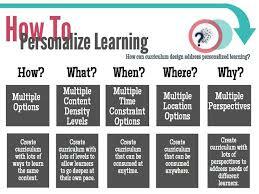e-Learning Ecologies MOOC’s Updates
Personalized Learning in High School
Personalized learning has been a buzz word since I began teaching nearly 16 years ago. “Personalized learning is generally seen as an alternative to so-called ‘one-size-fits-all’ approaches to schooling in which teachers may, for example, provide all students in a given course with the same type of instruction, the same assignments, and the same assessments with little variation or modification from student to student” (Edglossary.org). Instead of everyone doing the same thing, students are allowed to learn based on the interests, abilities, needs, and aspirations of students. This becomes even more feasible within a digital ecology.
With the advent of “blended learning”, students can work face to face with an instructor and classmates but also independently using a digital modality. Blended learning balances the necessary relationships that are so important in a secondary classroom with what each student needs. When I first began teaching within the “Big Picture” school network in the city of Detroit, each one of my students had a personalized learning plan. Using the student’s learning plan we attempted to “...mee[t] the learner where they [we]re, determin[e]where they need to be, and fin[d] and scaffol[d] the right zone of proximal development to get them there” (Patrick et al). Although the technology was definitely in its infancy compared to today, we tested each student’s reading ability so they could choose books they would encourage growth instead of frustration. Each student completed interest inventories, so they could pick an internship, which was a key part of our learning philosophy, that would enable them to learn real-world skills in an area of their choice. Students had to complete quarterly projects to show their learning in English, Math, Science, and their internship experience. It was a marvel to me as a new educator to be able to facilitate my students’ personal and academic growth. Imagine what we could have done with the technology available today?
Despite our best efforts some we were limited because of a lack of technology. Now “...blended learning is about the transformation of the instructional design toward personalized learning with teachers and students harnessing advanced technological tools to accomplish the shift toward personalization by design” (Patrick et al). We now get the strengths of the classroom and online modalities to optimize learning for each student. Learning more student-centered giving each learner control over time, pace, path, and place of learning. As a result of this fundamental the focus will not be solely on earning a passing grade but mastery. The technology is tailored to the student instead of the teacher, “The difference between solely using technology in addition to teacher-centered instructional models and understanding the fundamental shift using blended learning implementations toward transformed, student-centered instructional models is getting clearer” (Patrick et al). In the past, I had to direct my student’s learning plans. The educator was the driver. With blended learning, now students are in the driver’s seat.
Works Cited
Patrick, Susan, et al. “Mean What You Say: Defining and Integrating Personalized, Blended and Competency Education.” Eric.gov, International Association for K-12 Online Learning, 2013, files.eric.ed.gov/fulltext/ED561301.pdf
“Personalized Learning Definition.” The Glossary of Education Reform, 14 May 2015,www.edglossary.org/personalized-learning/.
“Personalized Learning: What It Really Is and Why It Really Matters.” EDUCAUSE Review, er.educause.edu/articles/2016/3/personalized-learning-what-it-really-is-and-why-it-really-matters.


